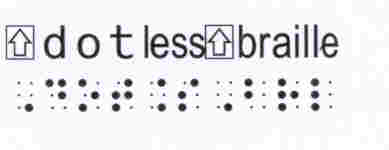 [D]
[D]
 [D]
[D]
Changing the electronic representation of transcribed braille from the 30-year old ASCII Braille to the new extended braille will make it possible for any sighted person, even one who doesn't know braille, to read braille directly.
The standard way of representing braille cells electronically uses 63 ASCII character codes for the 63 braille cells. There is also a Unicode prescription but I'm not aware of any braille applications that make use of it.
One advantage of ASCII Braille—actually a consequence of its violation of the Unicode philosophy of unique character codes for unique characters and symbols—is that sighted persons can choose to read ASCII Braille either as plain text or as inkprint braille dots simply by changing the font.
For example, the term DotlessBraille is written in contracted braille
using the cells:
,DOT.S,BRL
with the ASCII Braille displayed as plain text. If you
have either CAI's BRL2000 font or Duxbury's SimBraille font installed, then the next line will
display the corresponding inkprint dots:
,DOT.S,BRL
simply as a result of the change in the font specification.
ASCII Braille also has a number of disadvantages. In the first place, it takes quite a while for a sighted person to become adept at reading braille files as either plain text or inkprint dots. Consider, for example, the simple sentence, "Can you read this?"
When this sentence is transcribed to contracted braille, the word can is represented by the single-letter contraction "c", the word you by the single-letter contraction "y", the "ea" by the single cell for the "ea" contraction, and the word this by the single cell for the "th" contraction. And just to make things even more confusing, ASCII Braille represents the capitalization indicator with a comma, the "ea" contraction with the digit 1, the "th" contraction with a question mark, and the question mark with the digit 6.
,C Y R1D ?6
ASCII braille also causes difficulties for machine processing because the determination of the local meaning of the braille cells requires consideration of context.
Extended braille, in contrast to ASCII Braille and other standard digital representations of braille, uses separate character codes for each different meaning of the braille cells rather than for each different cell. Extended braille for Grade 2 braille has approximately 500 character codes rather than only 63.
Extended braille supports a directly readable print-like display by using the DotlessBraille font, a new font that has different glyphs for each different extended braille character code. (There is a companion font called XBraille which can be used for displaying extended braille as standard inkprint dots.) The DotlessBraille and XBraille fonts were recently created by an extremely talented and generous volunteer.
Here is the extended braille representation of the phrase "DotlessBraille"
with the extra characters that don't appear on a standard keyboard represented with numeric character
references:
ȠdotīĬȠƩƪƫ
ȠdotīĬȠƩƪƫ
ȠdotīĬȠƩƪƫ
Since the two fonts based on extended braille are not currently available for distribution, I've included a description as well as a picture of the previous two lines as they appear when displayed using the DotlessBraille and XBraille fonts. (The picture was obtained by scanning a printout of the appropriate selection from an earlier version of this page as displayed on my PC with the fonts installed.) I left the HTML here for future reference even though I of course realize that without the new fonts the line will not display correctly but will have funny characters and/or boxes for "missing characters".
DotlessBraille is a fixed-width font that can be aligned exactly with the XBraille companion font which displays the corresponding inkprint dots. In the sample picture each XBraille glyph appears directly below the corresponding DotlessBraille one.
Extended braille and the DotlessBraille font have the potential to revolutionize braille transcribing by making electronic braille directly accessible to sighted persons.
Home |
Site Map |
5-Minute Introduction
Page History: